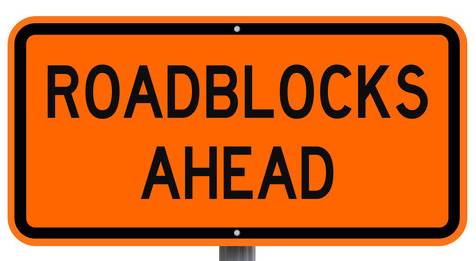Solutions for 3 Most Common Genealogy Roadblocks

When doing genealogy, not everything will be sunshine and unicorns. You will run into your fair share of research roadblocks. In this article, I cover three of the most common difficulties you are likely to face and provide some actionable plans for working around them. Without further delay, let’s get started.
Roadblock #1: Misspelled Names
It never ceases to amaze me how many genealogy records have
misspelled names on them. I estimate
that about 30% of the records in my family research collection have a
misspelling of the record owner’s name on them.
One particular record eluded me for years because the name was so badly butchered. The boat record for my great grandfather remained hidden because the name Joseph Hoesl had morphed into Jas. Hassel and would not show up on index searches no matter what I tried. Not being able to find this record caused me to consider offbeat scenarios like: he migrated through Canada or he tried to conceal his true-identity all the while his record was hiding in plain sight all along.
Sometimes, a translation mistake will be made during the indexing process. But most often a name was said aloud and a clerk or census taker did their best to record what they thought they heard.
Solution: Creative use of Search Engines
Don’t be too rigid about using exact name spellings in your searches. Keep a list of the most common misspellings for family lines you are researching and search on these variants also. Try searches using fuzzy or wildcard searches on family name coupled with secondary facts such as dates, locations, spouse or children to narrow down your search results.
Roadblock #2: Lost or Destroyed Records
Sometimes, natural disasters like floods or fires strike the places where records are stored and entire collections are wiped out. Records also can also be misplaced or mistakenly tossed out. Whatever the case, as a family researcher, you will inevitably run into a situation where the record you seek just doesn’t exist anymore.
When you find out your record was destroyed or lost, you can stop spending your valuable research time looking for it. It is best to view this insight as positive as it frees you to pursue other more productive research avenues.
Solution: Use other records to fill in holes in your data
Seek other sources such as tombstone inscriptions, church records, vital records, newspapers, court records, war pension files and land records to fill the information void left by the missing record.
Roadblock #3: Ancestors living before 1850
As you trace your family tree further back in time, you will likely find the paper trail to be sparser and harder to follow. U.S. Censuses conducted prior to 1850 typically only listed the head of household and track other household members with a series of tick marks and numbers. These early censuses make locating spouses and children very difficult.
Outside of New England, birth and death records become virtually non-existent. Grave markers may be lost or unreadable. Documents may have been lost to disasters or the ravages of time. Additionally, your ancestor may have moved around in search of land or opportunity, leaving behind only a few scattered clues.
Solution: Dig deeper to find scarce records
The first key to finding traces of your ancestors is learning about the geography and history of your ancestor’s region. In the early 1800s, county and state boundaries were still changing in much of the United States. This can affect where you will need to look for records today.
Even if your family never physically moved, information about them might be scattered as jurisdictions changed. See Using the Newberry Atlas of Historical County Boundaries for information on how to use this valuable online resource to track historical boundary changes.
Court probate records are one of the most reliable
indicators of kinship for early ancestors and are well worth pursuing. Land deeds can reveal valuable information
about ancestors as well as track their migrations from one place to another.
Published county and town histories may offer clues to further your research, particularly if your ancestor’s offspring remained in the area. These books were popular in the late 1800s and early 1900s, and often contain accounts of early settlers.
Historical newspapers from the localities of your ancestors can be a treasure trove of information about the people living in the area. Specifically, notices of births, deaths, wedding engagements and obituaries may allow you to discover details you could find nowhere else. There are several free internet-based sources for newspapers. Consult Genealogy Guide to Historical Newspapers for more information on tracking down your ancestor’s local newspaper.
The bottom line is that none
of these roadblocks should keep you from making significant forward progress in
your genealogy research. Once you
understand the potential hazards and how to work around them, you will be
unstoppable.
Read related articles: Breaking Through
Brick Walls
Beginner
Guide
Genealogy Quick Start Guide for Beginners
Applying the Genealogy Proof Standard to your Research
Google Genealogy Research Toolbox
Find Records
Researching Ancestors through Military Records
Using the National Archives (NARA) for Genealogy Research
Using U.S. Census Records
Canadian Genealogy Research using the Internet
Tips
Genealogy Source Citations Made Easy
Listening to Genealogy Podcasts Made Easy

